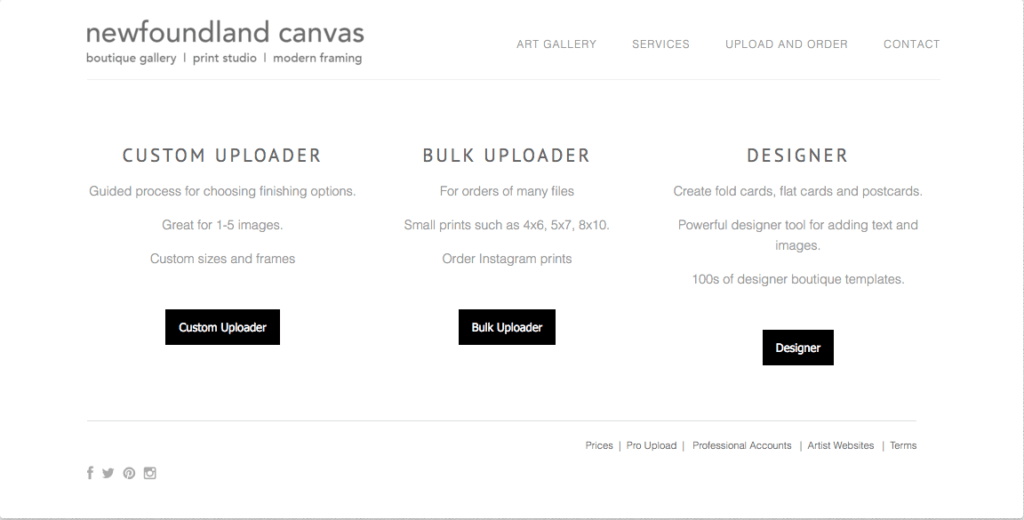
Choosing the Perfect Web-Ordering Software for Your Printing Business
Are you looking for the one stop shop web-ordering software for your printing business that will effectively and efficiently solve every single need of every given customer that visits your website and is concsidering placing an order?
Hard to say no to that one right?
Well we are happy to announce we have found it.
It’s brand new and it’s called the Silver Bullet™ Software.
Guaranteed to be your #1 sort-all-your-ordering-issues-handle-your-framing-and-shipping-too solution!
It literally makes fish jump into the boat, velvet ropes part ways, and traffic lights turn green on command.
You get the gist right?
Silver bullets don’t exist.
And neither does an ordering software that will handle every single need of every customer of an art & photo printing company.
This kind of solution just doesn’t exist, and it never will, because no platform can possibly handle ALL of the dynamic, extremely varied needs of businesses in our industry.
Yet so often we find the discussion turning around the search for a silver bullet.
“If I could just find this one solution, everything would be perfect.”
Of all the multi-million dollar art and photo printing companies – (Bay Photo, White House Custom Colour, and Millers, as examples) – not a single one of them is using a single, monolithic software application to serve all of their customers.
Instead, they all use a combination of different ordering software applications that are individually great at what they do, each serving a specific segment of customers and their needs.
A Multi-System Approach
So, let’s dive into the reasons why it takes a stack of software to successfully run a high volume and dollar print studio.
The truth is, if you try to force every art and photo customer to use one piece of ordering software, you’re going to end up with a portion of happy customers, a portion of frustrated customers, and a portion of missed or lost customers.
If you collect this data, you could actually see it clearly on a pie chart.
Therefore, if your business strategy is based on the premise of finding a “silver bullet” ordering software or you have dreams of building your own, it means your business strategy is inherently (and perhaps fatally) flawed.
We here at Art Storefronts understand exactly why the largest art and photo printing companies choose to leverage multiple pieces of software, and why that approach makes logical business sense.
It all starts with the customer
Despite the fact that you might be servicing artists, photographers, or both, these customers are not one big group with all the same needs.
Even the needs of two wedding photographers can be dramatically different depending on what each of them need to order at a given moment in time. One may require a single canvas print of a high res image while the other needs a 4×6″ print of 150 different high res images.
What Diverse Needs Look Like in Practice
Here’s a simple example that highlights a key difference between the ordering experience provided by eCommerce vs. desktop software from the vantage point of two wedding photographers – each with different needs.
Wedding Photographer “A”
Photographer “A” has 150 extremely high resolution files and needs to order a bunch of 8×10 prints and a handful of other sizes for particular images as well.
If she uses desktop ordering software, she can simply import them into the software. Unlike uploading to a website, this is a near-instant process and allows her to get this order placed very quickly.
This is because her desktop computer already knows what the size and specifics are of each file, so it doesn’t need to spend time receiving or analyzing each of them.
As you can see, this is a convenience that only desktop software can provide for this specific customer need. Therefore, if your goal is to provide an excellent experience for this type of customer, and this type of order, desktop software should be part of your offering.
While it will still be functional, forcing customers in this situation to use your eCommerce process may lead to a portion of them becoming frustrated.
Wedding Photographer “B”
On the other hand, our Photographer “B” has two high resolution files, and needs to buy 1 canvas gallery wrap and a metal print.
They need a company to purchase these from, and they simply want to upload these images and buy a print right now.
This is where the eCommerce ordering experience is critical, because it is the easiest, lowest friction way for a customer (especially a new one) to place an order.
With eCommerce, this customer simply goes to your website, is immediately prompted to upload the files, buys as many prints in as many ways they want, and can checkout as a guest or create an account. All of this is accomplished in one to two minutes, and they can get back to their day.
Therefore, if you want to provide an excellent experience for this wedding photographer “B”, offering easy and simple eCommerce is critical.
If you don’t offer this, and instead force customers with these types of needs to download your desktop software, or go through a cumbersome and confusing ordering process, there will be a portion of them who express frustration, and another portion that you will never even acquire.
The Solution: Cater to Both
If you are dedicated to customer satisfaction and would like to serve the needs of both of these customers, then in this case you would benefit from providing both an eCommerce and a desktop ordering experience.
You may think you can’t afford both, but chances are you probably can when you analyze Return-On-Investment on each (we will do this later in the article).
With the needs of our photographers “A” and “B” in mind, it’s easy to see why the largest players in the industry let the customer choose between multiple ordering options. Both customers in our example will end up highly satisfied.
High satisfaction leads to higher customer retention and increased word-of-mouth referrals. These are the ingredients that ultimately turn small companies into large companies.
Real-World Example 1: Bay Photo
Let’s look at how a real-life printing company, Bay Photo, demonstrates a tremendous understanding of customer need.
When you land on their home page, they gently guide the customer to order via eCommerce.
Bay Photo, like others, know that eCommerce is the #1 way to acquire new customers because of its simplicity, and it’s clearly their top priority.
Next, they have an “Order” button which presents three distinct ordering options: eCommerce, Downloadable Software, and a Designer Tool.
Three different software applications, which collectively provide an extremely well-rounded experience for customers.
Real-World Example 2: Newfoundland Canvas
Newfoundland Canvas, a very successful company ran by fantastic people, also demonstrates great understanding of customer need. When someone is interested in placing an order on their website, they are likewise presented with three options based on customer need.
How You Can Compete
I’m a small business! How can I afford multiple types of ordering software?
First, you need to eradicate the mindset that all of your money must go into a single version of “ordering software.”
As we already outlined earlier, none of the most successful companies in your industry think or operate in this way, so you shouldn’t either!
Once you’re over that psychological hurdle, you can now analyze each type of ordering software independently, and strictly determine its individual value to your business by calculating the Return On Investment (“ROI”) it is providing.
If a given piece of software is earning you a return on your investment (or appears to be on a clear path to doing so), then that means it is making your business better right now, and it therefore makes sense to continue investing in it.
Calculating ROI
Here’s a simple example: Let’s say you are paying $300 per month for a given piece of software.
Let’s assume your business earns an average 50% profit margin on its print sales. If you sell $600/mo. of prints through the software, you will earn $300/mo. in profit.
This means you have broken even with your software investment, and your ROI is 0%.
Now, let’s instead say you are selling $900/mo. in prints.
At a 50% profit margin, your profit is $450/mo.
Over a 12-month period, your total cost of the software will be $3,600 ($300 x 12) and your total profit will be $5,400 ($450 x 12). Therefore, the software contributed an additional profit of $1,800 to your business during that year.
This time, your ROI is 50% ( ($5,400 – $3,600) / $3,600 ).
Let’s now see what this software will earn you over a 5 year period. Let’s say your revenue earned on this software increases by only $300/per month during each subsequent year. For example, in year 2, your profit will jump from $5,400 to $7,200. Here’s what your profit will be each year during that 5 year period:
| Year 1 | $5,400 | ROI = 50% |
| Year 2 | $7,200 | ROI = 100% |
| Year 3 | $9,000 | ROI = 250% |
| Year 4 | $10,800 | ROI = 300% |
| Year 5 | $12,600 | ROI = 350% |
As you can see, just by increasing your year-over-year revenue by $300/month (a very realistic and achievable number), your ROI continues increasing, meaning your investment is paying off at a continually increasing rate.
Despite the additional up-front cost, you are very quickly making more money than you would have without the software.
Therefore, your goal is to earn an ROI on each software.
So long as each software is earning you a positive ROI, you are making money from it and it likely makes sense to keep each in place.
Removing an established ordering offering creates all sorts of problems – you lose profit that that software helped you earn, customers who are used to the experience it provided will be in disarray, etc.
Instead, think like the biggest industry players: calculate and then maximize the ROI of each software.
Maximize Your ROI
Once you understand your ROI, you may need to add/remove features that are affecting your cost.
If your ROI is low, you may want to remove unnecessary features in order to lower your costs. If your ROI is high, you probably want to add features and seek ways to further increase the success you’re already seeing.
Sometimes this is all easier to understand if we switch the analysis to types of printers instead of types of ordering software.
If a specific type of printer (let’s say an Epson 9900) is earning you a strong ROI, then it makes sense to keep using it to serve the specific customer needs the printer excels at.
If you instead ditch that type of printer and force all of your customers into an Epson solvent printer, you’re definitely going to have some unhappy customers. The quality and experience of these printers from a customer standpoint can be very different, so it makes a lot of sense to keep your Epson 9900.
If you find that there is an unfulfilled need that the Epson solvent printer fulfills, however, then it probably makes sense to supplement your business with it.
As you can see, it is not, and should never be, an all or nothing proposition.
So, Why Can’t a Silver Bullet Exist?
As a business owner, you well know that when a company tries to do everything, they end up being great at nothing.
Likewise If a company tries to build a software application that is all things to all people, you can pretty much ensure that it will be great at nothing.
How Art Storefronts Fits In
Let’s take Art Storefronts, for example. We are the industry leader at providing an eCommerce ordering software for art and photo printing companies.
What makes us an industry leader are several key things. Most important are customer conversion rates (CCR’s).
CCR is the percentage of visitors who come to your website and actually place an order, divided by the total number of visitors who come to your website.
In simple terms, CCR is the key performance indicator that grades the effectiveness of your eCommerce.
If you offer eCommerce, this is something you can and should grade yourself on right now.
A low CCR means you are leaving a lot of money on the table. Here’s a quick example. Let’s say your business currently does $100,000 in eCommerce sales annually, and you currently have a 2% conversion rate.
Then you implement a new ordering software that lifts your conversion rate to 4%.
That 2% increment is actually 100% growth in your conversion rate (going from 2% to 4%), which means you will see somewhere around 100% growth in revenue.
So just by adding a software that increased your conversion rate, you just added another $100,000 in revenue without spending any more money on marketing or doing anything different than you currently are.
This is why knowing and tracking your CCR matters.
Art Storefronts is currently the only company who regularly discusses and publishes CCR’s, and they are typically even higher than the previous example.
Let’s take a look at the data of one of a few of our customers:

Sample CCR from a fine art printing company using ASF.

Sample CCR from a professional photo lab using ASF
Delivering these high conversion rates, and all of the other important aspects of improving our eCommerce performance, is more than a full-time focus for Art Storefronts.
Despite the incredible results our customers enjoy, there is much more we can do and we will do to help them make more and more money from it. We’re really excited about it.
If we didn’t focus entirely on this aspect, and instead spent our time and resources expanding the software so that it could become “all things to all people,” then someone else would eventually be better than us at delivering the highest CCR within eCommerce.
At that point, you’d make a lot more money using their tool for eCommerce as opposed to ours.
The best business decision is to take the best-in-class tools for each customer ordering need and implement it. Stop paying for anything that doesn’t deliver or doesn’t provide you with performance data like CCR’s so you can understand what you are paying for.
Regardless of what ordering software you might be using at this time, demand to see what the CCR’s are. If you don’t have a handle on this number, then you’ll never have any idea of whether it is worth it to keep paying for what you are paying for.
Tracking CCR’s is a standard feature within the Art Storefronts site manager.
We don’t do this to boast about our performance (okay, maybe a little), we actually do this because this metric is widely recognized in the marketing community as being key for a business owner to track and manage over time.
Key Takeaways
- There is no silver bullet print business software and there will never be a silver bullet. Not even if you have millions to spend and try to custom develop it yourself.
- Your goal as an art/photo printing business is to utilize any type of software that fulfills your customers’ needs so long as it earns you an ROI.
- Every piece of ordering software, like any type of printer you invest in, should be analyzed independently in terms of its cost and ROI. Get your tracking in place.
- If you can only afford one software solution right now, your top priority should be eCommerce. The biggest printing companies push for it because it will likely bring the highest percentage of revenue from all three types of software – so make sure you have a great solution in place.
- Once you have earned an ROI on any given ordering software, you should consider incrementally adding features to further increase the ROI. You should also consider supplementing your business with other types of software that may fulfill other unfulfilled customer needs.
- If you’re having trouble earning an ROI, consider removing features in order to lower costs.
Sell More Art Online
If we can't teach you, no one can!



















